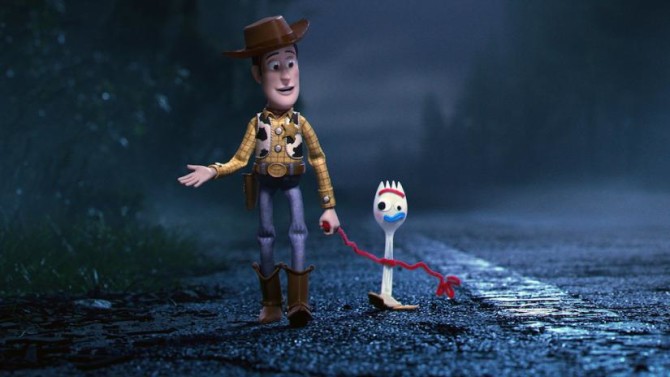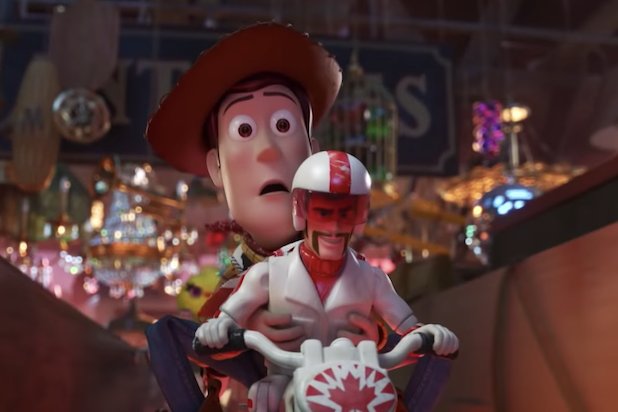Is Toy Story 4 yet another unneeded sequel, like Dark Phoenix, or does this fourk-el fly like the phoenix?
Genre: Animation
Premise: When the toys’ new owner, Bonnie, makes a toy at her first day at kindergarten called Forky, Woody and the crew must ensure Bonnie doesn’t lose him.
About: Pixar’s flagship franchise is back! One of the cool things Pixar does is they pull a relatively unknown writer out of obscurity and pair them with the excellent story team at the studio. This time that writer is Stephany Folsom, whose script, “1969 A SPACE ODYSSEY OR: HOW KUBRICK LEARNED TO STOP WORRYING AND LAND ON THE MOON,” made the 2013 Black List. She was paired with Pixar mainstay Andrew Stanton, who’s had a writing hand in almost every one of Pixar’s movies.
Writer: Andrew Stanton & Stephany Folsom
Details: 100 minutes
I’ve decided I don’t care about box office results for movies with 100 million dollar advertising campaigns anymore. It’s not the best indicator of audience interest when a movie’s advertising campaign basically grabs you and shoves you into your theater seat. “How did I get here again?” you ask, as your face wears the scars of a relentless marketing attack that ensured every other image you saw for the past month was one of this movie. I mean does anybody really care if Avengers bests Avatar at the box office? It wouldn’t even be a true win when you take into account inflation. All I care about when it comes to these movies going forward is, are they good? Which is why I’m so excited about today. Because Toy Story 4 is good.
Let me take a second to praise Pixar because it’s amazing how they handle their franchises, particularly Toy Story. In a world where studios don’t produce a movie anymore without making sure it sets up a sequel (or five), Toy Story is that rarity where all they care about is making each movie a singular experience. At the end of each Toy Story, you leave thinking that’s the last Toy Story movie they’ll make.
The downside of doing it this way is if the studio DOES decide to make a sequel, it’s all wonky and unstable because it was never meant to exist. Joss Whedon famously demanded Avengers be made this way. So when they made a sequel, it couldn’t live up to the original. The first one was about saving the world. The sequel was about… a floating island and bad Russian accents?
One of the reasons Toy Story (and specifically Pixar) is able to overcome this pitfall is because they take the time to work on the script. Toy Story 1 came out in 1995. Toy Story 2 came out in 1999, part 3 in 2010, and part 4 in 2019. Avengers 1, meanwhile, came out in 2012 and the sequel 2015. That extra time allows the Toy Story team to come up with concepts, when the concepts are bad reject them, keep trying, keep looking for something that works, and once they have it, write, then rewrite, then rewrite another 30 times until it’s right. Pixar is the ONLY studio that does this. And it’s why we have another winner today.
If you haven’t seen the film, it follows Woody and the rest of the toys as they prepare for a reluctant Bonnie’s first day at kindergarten. Terrified of this new experience, Bonnie only becomes comfortable once she creates Forky, a spork-like toy who’s obsessed with trash (the spork part of his body came from the trash). Woody realizes that Forky is now Bonnie’s most important toy, the only way she feels comfortable at kindergarten. So it’s all hands on deck to make sure Forky doesn’t get lost, a difficult task since he’s always trying to throw himself away.
This goal becomes infinitely harder when Bonnie’s family goes on an RV trip and Forky is constantly trying to run away. At one particular RV park, Forky gets kidnapped by a 1950s doll named Gabby Gabby at a nearby antique shop. The doll will only give Forky back if Woody gives up his voice box, which Gabby needs in order to become factory new again (and finally get the attention of the shop owner’s granddaughter). So Woody recruits Little Bo Peep, two stuffed carnival prizes from the nearby carnival, Buzz, and a Keanu Reeves’ voiced Duke Kaboom, to save Forky, all before Bonnie and her family head out to the next destination.
There are too many strong screenwriting choices in this script to count. Let’s start with the MacGuffin. Again, one of the best ways to structure a story with a lot of characters is to create a MacGuffin, the item in your story that everybody wants. The reason for this is, if you have a story with a lot of characters and no MacGuffin, you have to come up with individual goals for each and every character (or groups of characters). That’s infinitely harder to do. In the case of Toy Story 4, Forky is our MacGuffin. So even though there’s a lot of plot going on here, it’s never confusing because we always know that, at the center of the story, everyone’s trying to get Forky.
Another winning choice was to create a complex villain in Gabby Gabby. One thing I try and remind everyone is that when it comes to villains, playing against type can lead to a more memorable character. What’s less objectively threatening than a 2 year old girl? That’s our villain in Toy Story 4. On top of that, Gabby isn’t a villain just to be a villain. She has a goal. She needs Woody’s working voice box to replace her own broken one. On top of this, there’s an actual motivation for this goal. It isn’t just to be new. She’s hoping that the antique owner’s granddaughter will finally want to play with her if her voice box works. It’s an extremely strong emotionally-rooted goal/motivation, which is why Gabby Gabby is such a strong villain.
Understanding they can’t make Gabby too evil, lest she can’t be redeemed, the writers offload some evilness to Gabby’s minions, the creepy band of ventriloquist dummies who do her bidding. It’s choices like these that make the screenwriting in Pixar movies stand out. Because, when you think about it, most writers would’ve just made Gabby evil for evil’s sake. And even those who wanted a more balanced character wouldn’t have realized that extra evil characters were needed to fill in the evil gap.
Yet another awesome thing about Toy Story is the set pieces. I always tell the big idea screenwriters out there: find concepts that allow you to write original set pieces. One of the reasons the Toy Story franchise is so popular is because it’s so easy for the movies to give us set pieces we haven’t seen before. While the Fast and Furious franchise desperately attempts to find one last original car chase set piece, the shrunken down world of toys can build an entire set piece around an antique shop with an island cabinet tower that can only be accessed by a Duke Kaboom motorcycle stunt. That’s one of numerous set pieces in the film that feel like sequences we’ve never seen before. Remember that, in the end, the goal is to get people into the theater. If you’re not offering them something they can’t get anywhere else, they’re not going to come.
One of the trickiest things Toy Story 4 does is set up its stakes. Remember that these event movies don’t work unless the stakes are high. This is why, usually, the world (literally) will be at stake. Heck, in Avengers Endgame, half the universe is a stake. But not every movie is built that way. You can’t put the world at stake in a Toy Story movie. What you can do, ironically, is the opposite. You can focus on something narratively small but emotionally large. In this case, that’s Forky, or more specifically, who Forky is to Bonnie.
Toy Story 4’s biggest accomplishment is in how deftly it sets these stakes up. It does so with a single speech from Woody to the rest of the toys. He explains that Forky is Bonnie’s most important toy at the moment because it’s the key to her feeling comfortable at kindergarten. To be honest, I’m not entirely sure how they pulled this off. Somebody telling you the stakes of the movie is never as good as the stakes being revealed organically through plot (we learn how important R2-D2 is in Star Wars because Darth Vader is so relentlessly determined to retrieve him). But after Woody’s speech, we’re on board with saving Forky because the stakes are so soundly anchored in emotion (Bonnie needs him for emotional support). By the way, for all you beginner writers out there, you have to know that this scene is required in the first place. If we don’t understand the stakes of the movie, we’re not going to be invested. If Forky is just a new toy that the team doesn’t want to lose, the movie doesn’t work.
Some of the other things I liked were the ventriloquist dummies, specifically the way they moved. They nailed the creepiness of those dolls. The way they explained Duke Kaboom’s backstory was hilarious (the boy received him as a Christmas gift then discarded him because he couldn’t do the same jump he did in the commercial – “It was a commercial! You can never live up to the commercial!” Duke pleads to no one). I wanted a teensy bit more from Forky but he was fun. And I felt Gabby Gabby’s arc was expertly executed. I loved the red herring (“You can be Bonnie’s doll”) only – SPOILERS – for her to end up with a different girl lost at the park.
And, finally, probably the secret sauce of the Toy Story franchise is how perfectly they tap into the human condition. The stuff about Gabby believing that if she just gets her voice box then she can finally achieve what she wants in life is a metaphor that pretty much anyone in the world can relate to (if I can just get more money, if I can just lose these 20 pounds, if I can just get a car, if I can just finish this screenplay). Never underestimate the weight of tapping into those universal human experiences.
It’s too early for me to rank where Toy Story 4 falls in the Toy Story franchise. All I know is that I loved it. The script was so impressive, in fact, that I want to read that Stanley Kubrick script Folsom wrote to get the gig, which I’ll review tomorrow!
[ ] What the hell did I just watch?
[ ] wasn’t for me
[ ] worth the price of admission
[x] impressive
[ ] genius
What I learned: Folsom got her manager (Kaplan/Perrone) by working with some producers on a TV pilot that never took flight. A lot of writers are so focused on getting that agent or manager first, but usually it happens the other way around. Find some people who are in the business, even peripherally, and work on something together. Nothing may come of the project, but you’ll have access to the people they know, which may get you that coveted representation you’re looking for. Or at least a shot at it!



